Mathieu Lagrange
LS2N
Sound Scene Synthesis at the DCASE 2024 Challenge
Jan 15, 2025Abstract:This paper presents Task 7 at the DCASE 2024 Challenge: sound scene synthesis. Recent advances in sound synthesis and generative models have enabled the creation of realistic and diverse audio content. We introduce a standardized evaluation framework for comparing different sound scene synthesis systems, incorporating both objective and subjective metrics. The challenge attracted four submissions, which are evaluated using the Fr\'echet Audio Distance (FAD) and human perceptual ratings. Our analysis reveals significant insights into the current capabilities and limitations of sound scene synthesis systems, while also highlighting areas for future improvement in this rapidly evolving field.
Challenge on Sound Scene Synthesis: Evaluating Text-to-Audio Generation
Oct 23, 2024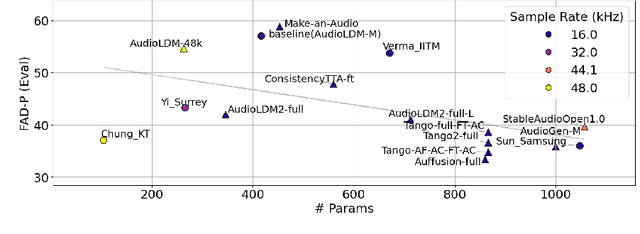

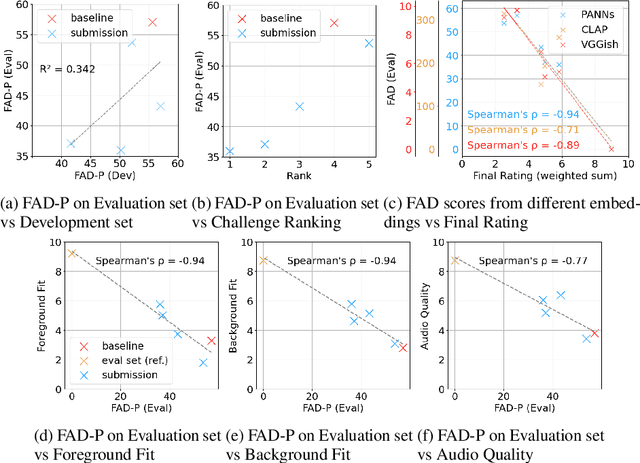

Abstract:Despite significant advancements in neural text-to-audio generation, challenges persist in controllability and evaluation. This paper addresses these issues through the Sound Scene Synthesis challenge held as part of the Detection and Classification of Acoustic Scenes and Events 2024. We present an evaluation protocol combining objective metric, namely Fr\'echet Audio Distance, with perceptual assessments, utilizing a structured prompt format to enable diverse captions and effective evaluation. Our analysis reveals varying performance across sound categories and model architectures, with larger models generally excelling but innovative lightweight approaches also showing promise. The strong correlation between objective metrics and human ratings validates our evaluation approach. We discuss outcomes in terms of audio quality, controllability, and architectural considerations for text-to-audio synthesizers, providing direction for future research.
STONE: Self-supervised Tonality Estimator
Jul 10, 2024Abstract:Although deep neural networks can estimate the key of a musical piece, their supervision incurs a massive annotation effort. Against this shortcoming, we present STONE, the first self-supervised tonality estimator. The architecture behind STONE, named ChromaNet, is a convnet with octave equivalence which outputs a key signature profile (KSP) of 12 structured logits. First, we train ChromaNet to regress artificial pitch transpositions between any two unlabeled musical excerpts from the same audio track, as measured as cross-power spectral density (CPSD) within the circle of fifths (CoF). We observe that this self-supervised pretext task leads KSP to correlate with tonal key signature. Based on this observation, we extend STONE to output a structured KSP of 24 logits, and introduce supervision so as to disambiguate major versus minor keys sharing the same key signature. Applying different amounts of supervision yields semi-supervised and fully supervised tonality estimators: i.e., Semi-TONEs and Sup-TONEs. We evaluate these estimators on FMAK, a new dataset of 5489 real-world musical recordings with expert annotation of 24 major and minor keys. We find that Semi-TONE matches the classification accuracy of Sup-TONE with reduced supervision and outperforms it with equal supervision.
EMVD dataset: a dataset of extreme vocal distortion techniques used in heavy metal
Jun 24, 2024



Abstract:In this paper, we introduce the Extreme Metal Vocals Dataset, which comprises a collection of recordings of extreme vocal techniques performed within the realm of heavy metal music. The dataset consists of 760 audio excerpts of 1 second to 30 seconds long, totaling about 100 min of audio material, roughly composed of 60 minutes of distorted voices and 40 minutes of clear voice recordings. These vocal recordings are from 27 different singers and are provided without accompanying musical instruments or post-processing effects. The distortion taxonomy within this dataset encompasses four distinct distortion techniques and three vocal effects, all performed in different pitch ranges. Performance of a state-of-the-art deep learning model is evaluated for two different classification tasks related to vocal techniques, demonstrating the potential of this resource for the audio processing community.
Detection of Deepfake Environmental Audio
Mar 26, 2024


Abstract:With the ever-rising quality of deep generative models, it is increasingly important to be able to discern whether the audio data at hand have been recorded or synthesized. Although the detection of fake speech signals has been studied extensively, this is not the case for the detection of fake environmental audio. We propose a simple and efficient pipeline for detecting fake environmental sounds based on the CLAP audio embedding. We evaluate this detector using audio data from the 2023 DCASE challenge task on Foley sound synthesis. Our experiments show that fake sounds generated by 44 state-of-the-art synthesizers can be detected on average with 98% accuracy. We show that using an audio embedding learned on environmental audio is beneficial over a standard VGGish one as it provides a 10% increase in detection performance. Informal listening to Incorrect Negative examples demonstrates audible features of fake sounds missed by the detector such as distortion and implausible background noise.
Correlation of Fréchet Audio Distance With Human Perception of Environmental Audio Is Embedding Dependant
Mar 26, 2024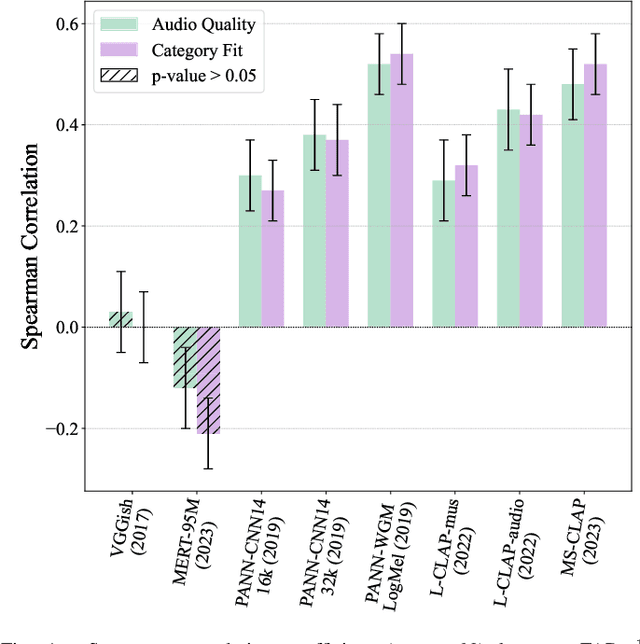
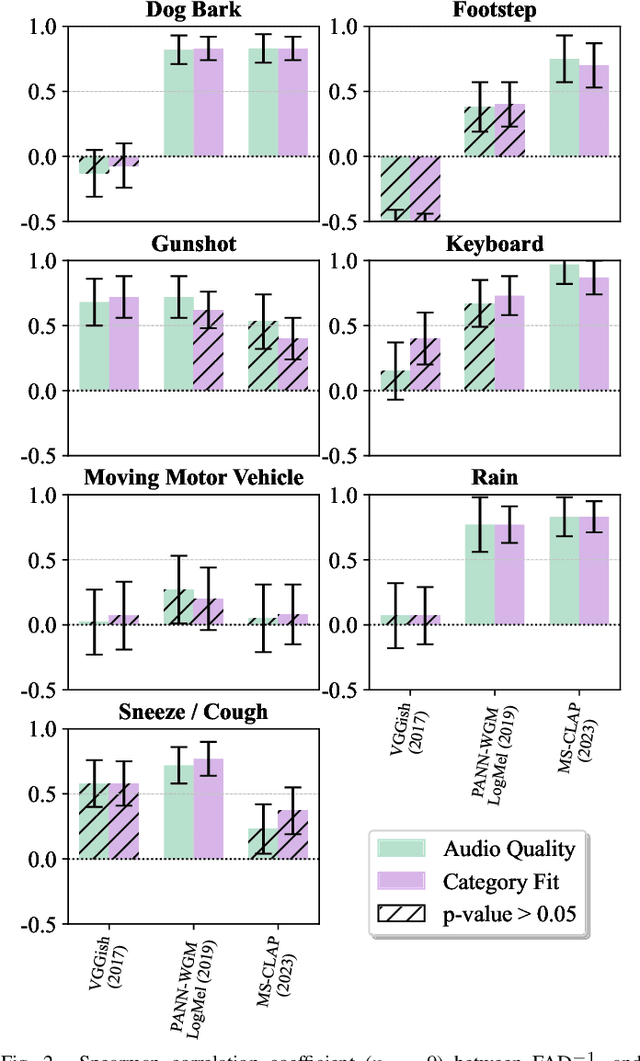

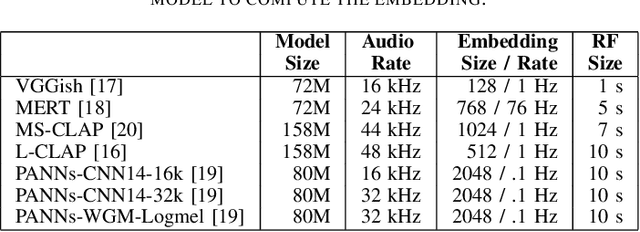
Abstract:This paper explores whether considering alternative domain-specific embeddings to calculate the Fr\'echet Audio Distance (FAD) metric can help the FAD to correlate better with perceptual ratings of environmental sounds. We used embeddings from VGGish, PANNs, MS-CLAP, L-CLAP, and MERT, which are tailored for either music or environmental sound evaluation. The FAD scores were calculated for sounds from the DCASE 2023 Task 7 dataset. Using perceptual data from the same task, we find that PANNs-WGM-LogMel produces the best correlation between FAD scores and perceptual ratings of both audio quality and perceived fit with a Spearman correlation higher than 0.5. We also find that music-specific embeddings resulted in significantly lower results. Interestingly, VGGish, the embedding used for the original Fr\'echet calculation, yielded a correlation below 0.1. These results underscore the critical importance of the choice of embedding for the FAD metric design.
Efficient bandwidth extension of musical signals using a differentiable harmonic plus noise model
Nov 27, 2023Abstract:The task of bandwidth extension addresses the generation of missing high frequencies of audio signals based on knowledge of the low-frequency part of the sound. This task applies to various problems, such as audio coding or audio restoration. In this article, we focus on efficient bandwidth extension of monophonic and polyphonic musical signals using a differentiable digital signal processing (DDSP) model. Such a model is composed of a neural network part with relatively few parameters trained to infer the parameters of a differentiable digital signal processing model, which efficiently generates the output full-band audio signal. We first address bandwidth extension of monophonic signals, and then propose two methods to explicitely handle polyphonic signals. The benefits of the proposed models are first demonstrated on monophonic and polyphonic synthetic data against a baseline and a deep-learning-based resnet model. The models are next evaluated on recorded monophonic and polyphonic data, for a wide variety of instruments and musical genres. We show that all proposed models surpass a higher complexity deep learning model for an objective metric computed in the frequency domain. A MUSHRA listening test confirms the superiority of the proposed approach in terms of perceptual quality.
Learning to Solve Inverse Problems for Perceptual Sound Matching
Nov 23, 2023



Abstract:Perceptual sound matching (PSM) aims to find the input parameters to a synthesizer so as to best imitate an audio target. Deep learning for PSM optimizes a neural network to analyze and reconstruct prerecorded samples. In this context, our article addresses the problem of designing a suitable loss function when the training set is generated by a differentiable synthesizer. Our main contribution is perceptual-neural-physical loss (PNP), which aims at addressing a tradeoff between perceptual relevance and computational efficiency. The key idea behind PNP is to linearize the effect of synthesis parameters upon auditory features in the vicinity of each training sample. The linearization procedure is massively paralellizable, can be precomputed, and offers a 100-fold speedup during gradient descent compared to differentiable digital signal processing (DDSP). We demonstrate PNP on two datasets of nonstationary sounds: an AM/FM arpeggiator and a physical model of rectangular membranes. We show that PNP is able to accelerate DDSP with joint time-frequency scattering transform (JTFS) as auditory feature, while preserving its perceptual fidelity. Additionally, we evaluate the impact of other design choices in PSM: parameter rescaling, pretraining, auditory representation, and gradient clipping. We report state-of-the-art results on both datasets and find that PNP-accelerated JTFS has greater influence on PSM performance than any other design choice.
Fitting Auditory Filterbanks with Multiresolution Neural Networks
Jul 25, 2023


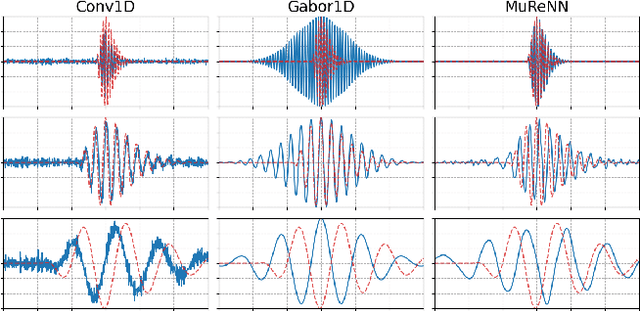
Abstract:Waveform-based deep learning faces a dilemma between nonparametric and parametric approaches. On one hand, convolutional neural networks (convnets) may approximate any linear time-invariant system; yet, in practice, their frequency responses become more irregular as their receptive fields grow. On the other hand, a parametric model such as LEAF is guaranteed to yield Gabor filters, hence an optimal time-frequency localization; yet, this strong inductive bias comes at the detriment of representational capacity. In this paper, we aim to overcome this dilemma by introducing a neural audio model, named multiresolution neural network (MuReNN). The key idea behind MuReNN is to train separate convolutional operators over the octave subbands of a discrete wavelet transform (DWT). Since the scale of DWT atoms grows exponentially between octaves, the receptive fields of the subsequent learnable convolutions in MuReNN are dilated accordingly. For a given real-world dataset, we fit the magnitude response of MuReNN to that of a well-established auditory filterbank: Gammatone for speech, CQT for music, and third-octave for urban sounds, respectively. This is a form of knowledge distillation (KD), in which the filterbank ''teacher'' is engineered by domain knowledge while the neural network ''student'' is optimized from data. We compare MuReNN to the state of the art in terms of goodness of fit after KD on a hold-out set and in terms of Heisenberg time-frequency localization. Compared to convnets and Gabor convolutions, we find that MuReNN reaches state-of-the-art performance on all three optimization problems.
Foley Sound Synthesis at the DCASE 2023 Challenge
Apr 26, 2023


Abstract:The addition of Foley sound effects during post-production is a common technique used to enhance the perceived acoustic properties of multimedia content. Traditionally, Foley sound has been produced by human Foley artists, which involves manual recording and mixing of sound. However, recent advances in sound synthesis and generative models have generated interest in machine-assisted or automatic Foley synthesis techniques. To promote further research in this area, we have organized a challenge in DCASE 2023: Task 7 - Foley Sound Synthesis. Our challenge aims to provide a standardized evaluation framework that is both rigorous and efficient, allowing for the evaluation of different Foley synthesis systems. Through this challenge, we hope to encourage active participation from the research community and advance the state-of-the-art in automatic Foley synthesis. In this technical report, we provide a detailed overview of the Foley sound synthesis challenge, including task definition, dataset, baseline, evaluation scheme and criteria, and discussion.
 Add to Chrome
Add to Chrome Add to Firefox
Add to Firefox Add to Edge
Add to Edge